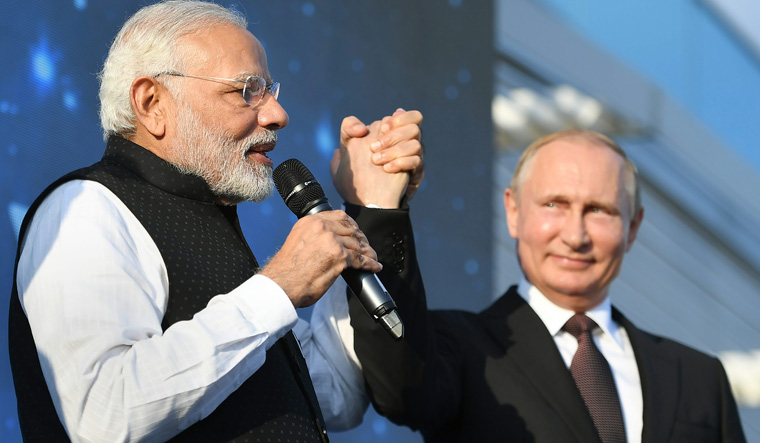Amidst the Sino-India border tensions and military standoff at the Line of Actual Control (LAC) in Eastern Ladakh, an interesting geopolitical situation is building up. India has reached out to its allies for arms and ammunition. India’s defence partners in the West- Israel, France, and the US have pitched in.
The democratic world, of course, supports India in its battles with an autocratic China. But at the same time, India has also managed to secure support from its biggest defence partner, Russia. This could unpuzzle the global equations and tilt them even more heavily against China, as New Delhi gives Moscow an opportunity to lose the tag of a global pariah.
Russia will supply one billion US dollars-worth of ammunition, anti-tank guided missiles (ATGMs), and Man-portable air-defence systems (MANPADS) to its friend, India. At least for the time being, Russia and the US are on the same page over one issue.
This is Russia’s message to China. Beijing was keen on ensuring that Russia doesn’t take sides amidst spiralling military tensions between India and China. The Xi Jinping regime in China expressly wanted Russia to avoid exporting arms to India.
But India has managed to secure the support of its biggest defence partner. China wanted to delay the delivery of S-400 Triumf, which is arguably the world’s best air defence system, to India. But Moscow has decided to speed it up on India’s request.
India is going to fast-track the purchase of 21 MiG 29s and 12 Sukhoi Su-30 MKI fighter aircraft from Russia. More importantly, this is happening amidst an ostensible show of camaraderie between Russia and China.
It is also no coincidence that the first overseas Ministerial-level visit from the Modi government in the post-Pandemic world was Defence Minister Rajnath Singh’s visit to Russia on the occasion of the 75th Victory Day.
The Putin administration is making it clear that Russia has to have a functional relationship with China only because of the extensive sanctions imposed by the United States and the European Union (EU). But the ties between India and Russia stand unscathed.
Russia has stood firmly behind India in tough times including the 1971 Bangladesh Liberation war. Now, if things get down to an armed conflict between India and China, Moscow will align strongly with New Delhi at the expense of Beijing.
This has larger geopolitical repercussions too, especially at a time when the democratic world wants to have more to do with India, the biggest democracy in the world.
Russia was sanctioned by the US after the annexation of Crimea in 2014. The EU had made a huge issue out of the Crimea episode, and Trump had to naturally force severe sanctions against Moscow.
Even after Crimea voted overwhelmingly in favour of Russia, sanctions were not lifted from Moscow. American sanctions are painful as they weaponize the global dollar-based banking transaction system, and target every single company using the US dollars or operating Stateside subsidiaries.
Russian companies like Rusal Aluminium and Rosneft Oil have been blocked from using the dollar-based financial system. Moscow tried using currency swap agreements, and attempt to de-dollarize have helped but the Russian economy continues to be in bad shape.
For Moscow, showing camaraderie with China is a matter of compulsion, not choice. Declared a global pariah, Russia has to bolster trading ties with China to support its own economy.
What Russia’s aid to India however does is shake Washington’s anachronistic perception of a triangular world order consisting of Russia, China and the US. The Trump administration envisages a China-Russia axis that it has to combat.
But Moscow has found the best PR for itself by coming to India’s rescue against China. India is seen as a fair player against a hawkish China, and therefore Russia gets to show that it is a player the world can interact with.
We are not saying that the United States and Russia have to be the best of friends. They cannot be friends- it is well known with all the history of the Cold War behind them. But there has to be an increasing awareness of the fact that the real threat to the US-led world order is China, not Russia.
There is no need to antagonise Russia and push it closer to China. It doesn’t have to be outcast, because that only makes Beijing stronger.
This is where India figures prominently in the changing world order. India is getting attracted towards the US but it is not alienating Russia either. Now, as India gets closer to the US, Russia can get pulled along with India and drawn further away from China. In fact, Indo-Russian ties are the only hope for Russia to emerge out of the darkness that China has to offer.
As for Trump, he has come to realise that the EU is useless and doesn’t have a clear-cut policy against China. EU’s opposition to ease sanctions on Russia is not as relevant today as it was in a pre-Coronavirus world. The biggest mistake that the US has made is to concentrate far too much on Russia and ignore China which has already grown into a giant bully.
Trump realises that too, and this is why he takes decisions like inviting Putin for the expanded Group of 7 (G-7) Summit, an alliance against Beijing. Canada and the UK opposed the invitation, and Trump meets with criticism and conspiracy theories from Democrats and media outlets within his country. But Trump rightly says its ‘common sense’ to invite Russia.
The opinion of Russia might change if it helps India in the worst-case scenario of a Sino-India military conflict. Perceptions with governments and leaders across the country will change, and Moscow will come out looking far more responsible.
India is Russia’s key to come out of the China quagmire that it finds itself in. And Putin is using it smartly.
